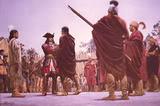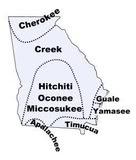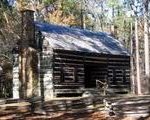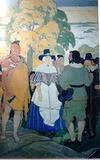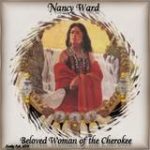Queen of the Creek?
Image: General James Oglethorpe
Meeting with Tomochichi and Mary Musgrove
Mary Musgrove was born Coosaponakesee sometime around 1700, at Coweta Town on the Ockmulgee River in northern Georgia. Her father was an English trader from the South Carolina Colony and her mother was a Creek Indian of royal blood – a niece of the emperor of the Creek Nation. Mary spent her first 10 years among her mother’s people, becoming thoroughly acquainted with the Creek language and ways. Despite her mixed heritage Musgrove was considered a full member of Creek society and the Wind Clan. In this matrilineal society children took the clan identities of their mothers.
Mary Musgrove was brought to South Carolina in 1710 to live among the English, where she was in her own words “baptized, educated, and bred up in the principles of Christianity.” This double allegiance – to the Creek Nation and the English Crown – was to make her a vital figure in the colonial settlement of Georgia. Mary was a tiny woman about five feet tall, wore her hair in two long braids with a band of beads across her forehead, and a feather stuck into the band.
Colonel John Musgrove was commissioned by the Governor of South Carolina in 1716 to visit the Creeks and negotiate a peace treaty between the English and the Creek Nation. Young John Musgrove accompanied his father, fell madly in love with Mary, and immediately married her. The two of them set out to build a trading enterprise in the Georgia territory. Mary’s knowledge of the Creek language and customs was an invaluable aid to their success.
By 1730, the Musgroves had a prosperous trading post on the Yamacraw Bluff overlooking the Savannah River, near the place where General James Oglethorpe brought the first English colonists to Savannah in 1733. On February 12th of that year, General Oglethorpe – the founder of the colony of Georgia – sailed with four small boats up the Savannah River.
When he landed at Yamacraw Bluff, he used Mary (who was about 33 years old at that time) as his interpreter for his first meeting with the Yamacraw Chief (or Mico), Tomochichi, an imposing man who was six feet tall and 90 years of age. Tomochichi was very interested in Oglethorpe’s gun, which he called a fire stick.
Oglethorpe employed Mary as a negotiator to secure the peaceful cooperation of the Creeks in land settlements and trade. Mary’s plantation on the Savannah comprised the fairest and broadest acres in Georgia, and it supplied the struggling colonists with meat, bread, and liquor.
A shrewd businesswoman, Mary Musgrove required payment for using her broad acquaintance among the Creek leaders. Her service to General Oglethorpe and the English Crown played a vital part in the founding of the Georgia Colony. He regarded her as a valuable interpreter and employed her for a yearly salary of one hundred pounds sterling. She played a key role in keeping the Creeks on the English side.
When she and her husband moved to Savannah, Mary’s social prominence grew. Important Native American visitors who came to do business with the colonial authorities would pay formal visits to her home. English guests were also common and included a young Anglican rector, John Wesley, who later broke from the Church of England to found Methodism.
During this time, Mary managed to acquire considerable wealth by supplying the early colonists with food and liquor. She also acted as an agent for the British government and, at Oglethorpe’s request, made several trips to Frederica, then Georgia’s southern outpost, to gain intelligence about Spanish activities.
In 1739, John Musgrove died after contracting malaria, leaving his wife a 500-acre plantation, a large number of cattle and horses, ten indentured servants, and a deerskin trade. She was one of the wealthiest women in the colony.
In that same year, Mary married Jacob Matthews, who had been a servant of her former husband. Jacob was a colorful figure known as a critic of English authority, a successful planter, and a heavy drinker. Apparently, he worked hard but he also set himself up as the leader of the malcontents in Georgia and the chief critic of the authorities.The colonists especially disapproved of his camaraderie with the Creek.
Matthews was responsible for defending Mount Venture and commanded a small group of Georgia rangers. When fighting broke out between the Spanish and the British in 1742, the Creek supported the British, largely due to Mary’s influence. An army made up of Creek warriors and Georgia soldiers successfully drove back the Spanish forces. When Matthews died in 1742, Mary’s wealth increased substantially. The following year, Oglethorpe returned to England for good. Upon parting from Mary, he thanked her with a gift of a diamond ring and 200 pounds.
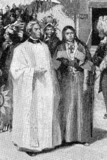
Image: Musgrove and Bosomworth
In 1744, Mary married Thomas Bosomworth, a figure even more controversial than Matthews. He had come to Georgia in 1741 to clerk for William Stevens, the man who would later be governor of Georgia Colony. He decided instead to join Oglethorpe’s troops on a mission to help defeat the Spanish. He soon tired of camp life and returned to England in 1743 to be ordained.
Thomas was appointed to minister to the colonists of Georgia for a term of three years and returned to America, but left before completing his term of service, returning to England once again in 1745, without his wife. He returned to Georgia the following year and was assigned agent to the Creek Nation by the colony of South Carolina. Bosomworth and Mary established a trading post at “The Forks,” the confluence of the Ockmulgee and Oconee Rivers.
Bosomworth set about winning the Creek Indians to his devious ways. He convinced Mary’s brother Malatchee to have himself proclaimed Emperor of the Creek Nation, who then gave Thomas and Mary a deed to the Sea Islands of Ossabaw, Sapelo, and St. Catherine. Thomas purchased vast herds of cattle on credit in South Carolina and turned them loose on St. Catherine Island.
Thomas also talked the Creek Nation into making Mary Queen of the Creeks. Mary, who still had the support of all the Indians, made an instant demand for surrender of all the lands that had belonged to the Upper and Lower Creeks.
In August 1749, Mary and Thomas were arrested due to debts Thomas owed in South Carolina for the cattle. The Indian Chiefs and the council president met on several occasions to negotiate the return of lands to the Indians. Bosomworth repented of his folly, and wrote to the council president apologizing for his wanton conduct.
During this time, Thomas continually fought to secure the money owed Mary for her services when she was working for General Oglethorpe. Mary resorted to the courts in London, and in June 1760, settled her claims for 2100 pounds sterling and clear title to St. Catherine Island. Musgrove relinquished her claims to the other lands, and ceased to play a central role in Georgia-Creek relations.
Mary Musgrove Bosomworth spent the remainder of her life on St. Catherines Island, and died there sometime after 1763.
SOURCES
Queen of the Creeks
Wikipedia: Mary Musgrove
Mary Musgrove Matthews Bosomworth
The New Georgia Encyclopedia: Mary Musgrove
